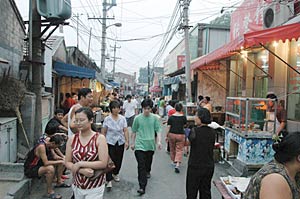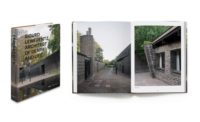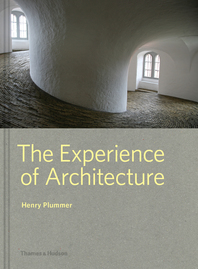A firsthand account of the Chinese capital's struggles to preserve its past in the face of rapid development and Olympic glory.
With a gross floor area of 3,875,000 square feet, the project had already gone through 36 master plans by the time the district government enlisted SOHO in early 2006. In the end, the original grid of hutong and their names were retained. Still, the government wanted the entire area remade quickly—by October, 2007—a deadline SOHO pushed back to approximately 2010. Nearly a half-mile long, the main thoroughfare has already been converted to a pedestrian shopping mall, centered by trolleys and fronted by remade buildings that are closely styled on those seen in a 1950 photograph of the street. Architects enlisted by SOHO include Ben Wood, who designed Shanghai’s open-air mall Xintiandi, and Yung-Ho Chang, of MIT.
“Yung-Ho understands tradition, as well as what architecture means in today’s environment,” Zhang continued. “It’s not an exact replica, as the buildings have to function in today’s world.” Although the construction uses modern materials—concrete frames, for example—Zhang said the results will not be a “fake movie set. It will look respectable as part of our history, and also as property that can be used today. If successful, it will work as a great model for other cities. There is a rush to save what’s left. There’s enough awareness now. We must try.”
Yet the project’s re-creation of old architecture using modern materials chafes preservationists, such as Beijing Cultural Heritage Protection Center’s Hu. “Every piece of brick carries historical value,” he said. “The exterior may look traditional, but the street itself will not carry any historical message. It’s another Xintiandi,” Hu lamented, referring to the Shanghai open-air mall whose vernacular architecture replicated that which it razed, and dispersed the community. “It sets a very bad example, as other cities will follow suit.”
Chang suggested that critics reserve judgment on the project. “The more interesting part is not on the main street and has not yet started construction,” he said. “The main street does not really have a different approach than other similar projects in Beijing. It’s a political project. Unfortunately, design does not matter much. Once inside of the neighborhood, there was more need for design innovation.”
My initial visit to the main street was postponed when the mayor arrived for an inspection. The next morning, I strolled down the avenue, paved with flagstones and lined with gray-brick buildings that formed a contiguous street wall. I was happiest to see benches, trash cans, potted flowers, and crab-apple trees. Unique to Beijing, the project invites pedestrians to sit and linger. How the site will be transformed by actual use, however (think security guards and shops that serve tourists, not locals), remains to be seen. What’s known is that the project will transform the neighborhood as redevelopment proceeds outward, like ripples on water.
This worries Chinese entrepreneur Kane Khan, who spent $375,000 renovating a historic hotel one block from the SOHO project. Though labor and material expenses are low, the cost of preserving a century-old building remains high. Restoring a single courtyard home requires the same paperwork as constructing a 20-story high-rise. Khan had originally budgeted $250,000 to restore the Qianmen (Front Gate) Hostel. Instead, he faced cost overrun after overrun, bringing the two-story brick building up to fire and health codes—not to mention the “gifts” he felt compelled to distribute to bureau officials. The city decreed his business would be a hostel; because it was a historic structure, Khan was forbidden to install ensuite plumbing or otherwise alter its infrastructure. Officials wouldn’t tell him the city’s plans for the surrounding hutong; the Hand could come along and paint when it pleased. As his business was about to open, the district government announced it was constructing a new upscale hotel directly across the street, in the antique style of the authentic structure he had spent so much to revive.
In the hostel’s open courtyard, as we sat surrounded by burgundy beams, green posts, and red lanterns, Khan dismissed praise for his work. “It would have been so much easier to build anew,” he said. “I figured that visitors wanted to see authentic Beijing.” Then he realized how hard it would be to dry out the damp walls, upgrade the electricity and plumbing, and install fire sprinklers. Local officials did not applaud him for installing solar water heaters; using gas would have increased its revenues. Khan fired the original designer after he began painting over the old wood, dating from the former teahouse’s inception in 1850.
After he paid for the hostel’s facade to be restored, a city directive ordered all neighborhood structures to look uniform, so government-hired workers arrived to cover the original brick with gray tiles. The sound of workmen carried into the courtyard, where Khan fingered one of his many new gray hairs. “This hotel was a secret Communist meeting place, when the party was being persecuted in the 1920s,” he said. “The carved wood screens in the rooms upstairs date to the 19th century. It’s so difficult to find stories and facts about old architecture. When I signed the lease, the building was being used as a dormitory for the Railway Bureau.” He pointed to a collage of photos he had collected during renovations: men standing on tracks and before East is Red diesel engines. “There isn’t even a plaque out front,” Khan lamented. “Will you write one?”
The Last Days of Old Beijing: Life in the Vanishing Backstreets of a City Transformed.




